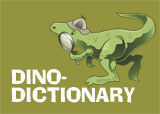Winter 2007
 |
||
Visit Dinosaurs in Their Time in this Illustrated Map! 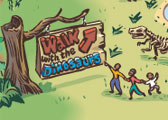 Click Here! |

It’s time someone told the larger story. Dinosaurs didn’t all live at the same time. They weren’t always at the top of the food chain, either. Some even had feathers. And now, the best place in the world to not only learn all about dinosaurs and their biodiverse worlds, but also walk among them—in their reconstructed digs—is Carnegie Museum of Natural History. Last month, the museum’s new super-sized exhibit, Dinosaurs in Their Time, opened in its first phase to throngs of Carnegie Museums members in a 48-hour preview that drew nearly 15,000 visitors. Days later, the exhibit debuted to the general public. And ever since, the talk across the region—even the world—has been all about Pittsburgh’s new, put-you-in-their-tracks dinosaurland. The Museum of Natural History’s blockbuster exhibit immerses its visitors in a world where dinosaurs rule but are hardly alone. Real skeletons, freshly cleaned, restored, and positioned in true-to-life poses, are situated in re-creations of the environments in which they lived, separated into the three distinct periods of the Age of Dinosaurs: Triassic, Jurassic, and Cretaceous. And museum scientists make good use of the museum’s vast collection of all kinds of fossils—some 210 specimens of plants, invertebrates, fishes, amphibians, reptiles, birds, and mammals—to re-create the lush world dinosaurs lived in. “Dinosaurs in Their Time is quite the sensation, and rightfully so,” says David Hillenbrand, president of Carnegie Museums of Pittsburgh. “We’re so incredibly proud of this exhibit, and thrilled for the millions of people who will now be the beneficiaries of the years of hard work that went into it. “We promised Pittsburgh a day-one dinosaur attraction, and that’s just what Carnegie Museum of Natural History has delivered,” Hillenbrand continues. “Now the world can see for itself that Pittsburgh is not only home to one of the world’s finest dinosaur collections but also one of the most accomplished teams of natural history scientists in the world, bar none.” One of those scientists, Matt Lamanna, the museum’s assistant curator of vertebrate paleontology, served as lead scientist on Dinosaurs in Their Time, a $36 million project well over two years—and eons of evolution—in the making. He knows every inch of the exhibit, and he’s finally allowing himself a moment to relish in what he and the extended Dinosaurs in Their Time team have created. “I’m just a big, grown-up kid who gets to play with real dinosaurs for a living, positioning them in ways we scientists believe they would have looked and interacted with their environments,” says Lamanna. “This project was a childhood dream realized. 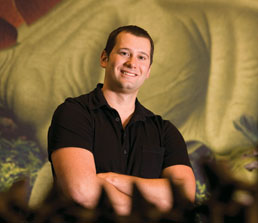 “This is the first time people have had the chance to see so many real dinosaurs displayed as they actually might have lived together and interacted.” “This is the first time people have had the chance to see so many real dinosaurs displayed as they actually might have lived together and interacted.” — Matt Lamanna, Assistant Curator of Vertebrate Paleontology“We’ve painstakingly re-created the worlds of the dinosaurs, from the plants they ate and walked on to the other kinds of animals that shared their respective ecosystems; everything that is displayed together actually lived together,” Lamanna continues. “It’s the first time people will experience dinosaurs in this way.” And they’ll encounter a few surprises along the way. Growing Up Dinosaur Visitors to Dinosaurs in Their Time begin their walk in the most distant past, the Triassic Period, 200-251 million years ago when the Earth was a one-continent world. It’s there they’ll find their first surprise. 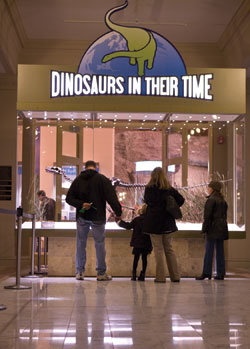 In this ancient world, dinosaurs were mostly small in size, and often the prey of bigger beasts. A case in point: As visitors enter Dinosaurs in Their Time’s Triassic section, they encounter the re-creation of the ancient environment of the Chinle Group, a rock unit that is most famously exposed at Ghost Ranch in north-central New Mexico. At its base lies a hefty block of rock containing the real fossil skeletons of a well-known early dinosaur, Coelophysis—laid out just as Dave Berman, Carnegie Museum of Natural History curator of vertebrate paleontology, found them in 1981. In this ancient world, dinosaurs were mostly small in size, and often the prey of bigger beasts. A case in point: As visitors enter Dinosaurs in Their Time’s Triassic section, they encounter the re-creation of the ancient environment of the Chinle Group, a rock unit that is most famously exposed at Ghost Ranch in north-central New Mexico. At its base lies a hefty block of rock containing the real fossil skeletons of a well-known early dinosaur, Coelophysis—laid out just as Dave Berman, Carnegie Museum of Natural History curator of vertebrate paleontology, found them in 1981. A mural behind the prehistoric gravesite shows what this small carnivorous dinosaur and the world it inhabited probably looked like. And standing guard over the bounty of the now-fossilized Coelophysis carcasses is the cast of a 20-foot-long carnivore, Redondasaurus, a reptile that resembles a modern-day crocodile, although it has no direct relation. “The first big animal in the exhibit isn’t a dinosaur; it’s a little bit of a curveball,” says Lamanna. “This area is meant to show that when dinosaurs first appeared, they weren’t the 80-foot-long behemoths we’re used to seeing. They were typically much smaller creatures, and their world was dominated by other kinds of animals.” Jurassic Jackpot The world changed plenty over millions of years, which is quite apparent as visitors enter Dinosaurs in Their Time’s Jurassic Atrium. After getting a brief introduction to life in Triassic and early Jurassic seas, visitors hop back on land and into the dusty, weathered boots of legendary Carnegie Museum dinosaur hunter Earl Douglass. In 1909, Douglass discovered what became known as the Carnegie Quarry, later designated the centerpiece of Dinosaur National Monument. Located in the northeastern corner of Utah, the quarry exposes part of the Morrison Formation, a vast deposit of late Jurassic rock that stretches across the American West. The quarry is home to North America’s greatest deposit of Jurassic dinosaur bones and many of the museum’s most famous and scientifically significant dinosaurs. 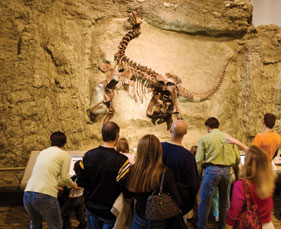 In a re-created, towering section of rock from this storied bone bed lies a juvenile Camarasaurus—the most complete skeleton of any of the long-necked sauropod dinosaurs ever found. Much of it is still encased in its original sandstone, just as Douglass and his crew discovered it back in 1919. Preserved in what’s known as the death pose, with its neck arching back toward its tail, the specimen is one of the world’s most iconic dinosaur fossils. In a re-created, towering section of rock from this storied bone bed lies a juvenile Camarasaurus—the most complete skeleton of any of the long-necked sauropod dinosaurs ever found. Much of it is still encased in its original sandstone, just as Douglass and his crew discovered it back in 1919. Preserved in what’s known as the death pose, with its neck arching back toward its tail, the specimen is one of the world’s most iconic dinosaur fossils.“The Carnegie Quarry is the main reason why our dinosaur collection is among the finest in the world,” says Lamanna. “It went on to yield 350 tons of dinosaur bones, many belonging to nearly complete skeletons, that were shipped back here to Pittsburgh. Many of our most spectacular Jurassic dinosaurs, except for Diplodocus and the baby Apatosaurus, came from that quarry.” Dryosaurus, one of the late Jurassic’s most advanced plant-eaters, was among them. Displayed for decades in the old Dinosaur Hall as a wall mount still embedded in rock and plaster, it’s the first of its species to be fully reconstructed and displayed as a freestanding skeleton. Quick-footed due to its long hind legs, Dryosaurus is coupled with a cast of a fierce-looking juvenile Ceratosaurus, one of the late Jurassic’s most vicious predatory dinosaurs, also on display for the first time. The pair is juxtaposed to tell the story of dinosaur diversification. Early on, dinosaurs split into two main groups named for, of all things, the differing structures of their hips. In saurischians, or “lizard-hipped” dinosaurs like Ceratosaurus, the pubis (the forward-most bone of the hip) points downward and forward. Long-necked vegetarians like Apatosaurus, Camarasaurus, and Diplodocus, as well as the meat-loving theropods Allosaurus, Tyrannosaurus, and Velociraptor, belong in this group. In ornithischians, or “bird-hipped” dinosaurs such as Dryosaurus, the pubis superficially resembles that of a bird, with an extension pointing backward towards the tail. All known ornithischians, including Stegosaurus, Camptosaurus, and horned dinosaurs like Triceratops, have an appetite only for the green, leafy stuff. And even though most scientists believe that birds evolved from dinosaurs, oddly enough, birds are thought to have descended from the lizard-hipped—not the bird-hipped—variety of these ancient reptiles! The Show Stoppers Every big show has its big stars. In the Phase One opening of Dinosaurs in Their Time, those show stoppers are the giant, long-necked sauropods. Dwarfed by these dinosaurs’ sheer enormity, visitors to the exhibit’s Jurassic Atrium eventually all assume the same position: neck stretched backward, jaw dropped, eyes peeled way up. And many of them ask themselves the same question: Are these really the same dinosaurs I saw in the old Dinosaur Hall? Most dominant is the towering woman-in-charge, Apatosaurus louisae, the 76-foot-long sauropod that measures 15 feet tall at the hips, once weighed in at as much as five bull elephants, and was named after Andrew Carnegie’s wife, Louise.  First mounted in 1915, louisae had stood in old Dinosaur Hall for decades, tail down, head hanging. Today she’s a protective mother guarding her offspring: head swung to one side, sizing up the threat behind her, her 30-foot-long tail in mid-swing, like a whip readied to strike. Her baby, a juvenile Apatosaurus probably not even a year old—the most complete skeleton of its kind ever found and the only one in the world on display—cowers in front of her, petrified by the imminent danger: a hungry Allosaurus that hopes to separate mother and offspring. Not far behind, as part of the world’s longest continuous dinosaur mural, the Allosaurus’ packmate charges into the fray, significantly elevating the peril. A spike-tailed Stegosaurus, the largest known plated dinosaur, stands squat among its herd, also depicted in the giant mural, bellowing in the direction of the slightly smaller but unrelenting Allosaurus. Visitors get to walk through and around, at times underneath, this life-and-death drama. The exhibit’s path winds beneath louisae’s tail and just a few dozen steps over to Diplodocus carnegii, the museum’s very first dinosaur, affectionately nicknamed “Dippy.” With his head turned facing louisae, it’s anyone’s guess if Dippy—who, like louisae, is the holotype for its species, the definitive, name-bearing specimen to which all others are compared—sticks around. While big, Dippy’s no fighter. And tucked not far behind him, ducking for cover, is Camptosaurus—yet another holotype and the best specimen of its species—a dinosaur that would have been easy prey for Allosaurus. “This is the first time people have had the chance to see so many real dinosaurs displayed as they actually might have lived together and interacted,” Lamanna notes. “That’s remarkable because, most times, when you’re walking through a dinosaur exhibit, you’re looking at a dinosaur from, say, the late Cretaceous of Mongolia displayed right next to one from the late Jurassic of Wyoming. What’s often not apparent is that those dinosaurs never encountered each other in life, not by a long shot. They are separated by thousands of miles, and, more importantly, almost a hundred million years. “Because our collection is so strong in fossils from the late Jurassic of western North America, no other museum in the world is as well-equipped as we are to reconstruct the environments of that time and place. And we’ve been able to re-create them in unprecedented detail, down to the leaves on the plants and the dirt beneath the dinosaurs’ feet.” Coloring the Age of Dinosaurs Three lifelike murals (a fourth will be unveiled in the Phase Two opening next spring) not only pop off the walls of Dinosaurs in Their Time and extend the lush environments of the dinosaurs, they literally color them. They add flesh to their bones, and give them pack and herd mates and other life forms not represented in the three-dimensional dioramas but that nonetheless shared the dinosaurs’ ecosystems. 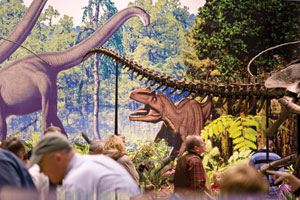 The largest—a massive, 180-foot-long, 2,640-square-foot mural believed to be the longest continuous dinosaur mural in the world—took more than a year to complete and extends the drama of the menacing Allosaurus trying to make a snack out of the baby Apatosaurus. Created by Philadelphia paleo-artists Walters & Kissinger in partnership with the museum, it recently captured the Society of Vertebrate Paleontology’s prestigious John J. Lanzendorf Prize for two-dimensional paleontological art. It’s one of the most scientifically accurate dinosaur murals in existence. The largest—a massive, 180-foot-long, 2,640-square-foot mural believed to be the longest continuous dinosaur mural in the world—took more than a year to complete and extends the drama of the menacing Allosaurus trying to make a snack out of the baby Apatosaurus. Created by Philadelphia paleo-artists Walters & Kissinger in partnership with the museum, it recently captured the Society of Vertebrate Paleontology’s prestigious John J. Lanzendorf Prize for two-dimensional paleontological art. It’s one of the most scientifically accurate dinosaur murals in existence. Members of the non-dinosaurian “supporting cast” get in on the action, too, via the giant murals: swarming sea monsters come to life as part of the backdrop to the exhibit’s Cretaceous Seaway; and sharp-eyed visitors can spy flying reptiles, an insect or two, and Fruitafossor, a small, primitive mammal tucked away in the mural that wraps around the Jurassic Atrium. “Usually when you see a mural in a dinosaur museum, it’s either totally disconnected from the real specimens in front of it or it’s an exact repeat of them,” says Lamanna. “We really wanted our murals to be neither of these things. We wanted them to extend the diorama scenes, and I think they do that. “For instance, the Jurassic Morrison Formation mural makes the unfolding attack scene that much more realistic,” Lamanna adds. “With a second Allosaurus as part of the scene, it changes things dramatically.” It’s a Bird, It’s a Plane, It’s a Dinosaur In the final section of the Dinosaurs exhibit, visitors are immersed in the third and final period of the Age of Dinosaurs, the Creta-ceous Period, 66-146 million years ago. It was a time when the Earth’s geography began to look more like it does today. The northern supercontinent, Laurasia, separated into North America and Eurasia, and its southern counterpart of Gondwana gradually broke apart to form South America, Africa, India, Madagascar, and Australia-Antarctica. Here, visitors pass through the reconstructed environment of the Jehol Group, a series of early Cretaceous rocks outcropping in modern-day northeastern China. About 125 million years ago, its landscape would have been dotted with huge lakes surrounded by conifer-dominated forests and volcanic mountains. A watermark on a reconstructed tree implies that visitors are, in a sense, wading through the shallows of a lake, looking up onto the shore at the plants and animals that lived there. 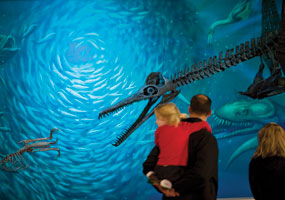 When dead organisms sank to the beds of these lakes, they were often buried intact by fine-grained sediments, and in many cases were preserved in tremendous detail. The one problem is that almost all Jehol specimens have been squished flat by the immeasurable weight of the rocks overlying them. When dead organisms sank to the beds of these lakes, they were often buried intact by fine-grained sediments, and in many cases were preserved in tremendous detail. The one problem is that almost all Jehol specimens have been squished flat by the immeasurable weight of the rocks overlying them.“Because they’re usually two-dimensional ‘road kill,’ you can’t just take a Jehol fossil slab and stick it in a reconstructed environment; it just doesn’t look right,” explains Lamanna. “So we’re displaying two-dimensional fossils or casts of Jehol animals, but we’ve also re-created, in three dimensions, what we think those animals would have looked like when they were alive.” Children especially, says Lamanna, should have fun spotting 10 life-size models of an early Cretaceous fish, frog, turtle, lizard, swimming reptile, bird, mammal, and other curious-looking creatures produced by renowned natural history artist Gary Staab, the largest of which might be mistaken for a pheasant or a small turkey. “The coolest thing about the Jehol Group deposits is they have produced the world’s only fossils of dinosaurs preserved with feathers on them—the most conclusive piece of evidence that birds are descended from dinosaurs,” Lamanna notes. “So people will look up and ask, ‘What is that thing, a turkey?’ It turns out, it’s a dinosaur.” And this dinosaur—Caudipteryx—was among the first and most primitive non-avian dinosaurs to be discovered with modern-style feathers. Winding farther north into a recreation of Mongolia’s Gobi Desert 80 million years ago, visitors find the real skeleton of a small Protoceratops, a forerunner of the famous horned dinosaur Triceratops, which will debut next spring in Phase Two of Dinosaurs. Sharing in that spotlight will be not one, but two Tyrannosaurus rex skeletons, one of which is the museum’s famed holotype, paired with the cast of a second T. rex in a violent rumble over the carcass of a fallen herbivorous dinosaur, Edmontosaurus. Also on view come spring 2008: the dome-headed Pachycephalosaurus and a new species of a toothless, bird-like oviraptorosaur soon to be given its own scientific name by Lamanna and his colleagues. 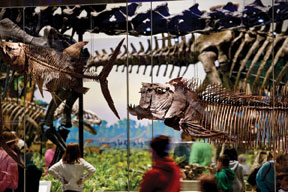 “There are a lot of hidden treasures in the exhibit,” says Lamanna. “We know that many of our visitors are repeat visitors, so we wanted to give them something new to discover every time they come back.” “There are a lot of hidden treasures in the exhibit,” says Lamanna. “We know that many of our visitors are repeat visitors, so we wanted to give them something new to discover every time they come back.”In addition to onsite information panels and touch screens displaying everything from how to pronounce a dinosaur’s name to the latest discoveries by Carnegie scientists, dinosaur enthusiasts can continue to mine the wealth of information in the exhibit from home via the museum’s website. After all, education and research are fundamental to the mission of the museum and the inspiration behind it’s largest expansion in exactly a century. “It’s one of the things we’ve gone to great lengths to do,” says Lamanna. “To illustrate the way dinosaurs lived, changed, and interacted with each other and with their environments; but also to show our visitors things they won’t see in any other museum—things that even make us scientists ‘geek out.’ “Lots of people, especially kids, are fascinated by dinosaurs. But more importantly, dinosaurs help keep science fresh, exciting, and accessible. If this exhibit sparks peoples’ interest in science, or helps to inspire the next generation of researchers, then I can rest easy knowing that we’ve done our job.” |
|
Also in this issue:
Tales from the Supporting Cast · From Trophies to Treasures · The Popular Salon of the People: Then and Now · Director's Note · NewsWorthy · Now Showing · Face Time: Diplodocus carnegii · About Town: International Appeal · First Person: It takes a village to raise a dinosaur · Artistic License: Size Matters · Science & Nature: Bodies of Knowledge · Another Look: Neapolitan Presepio Celebrates
 |
Copyright © 2017 CARNEGIE Magazine. All rights reserved. |

